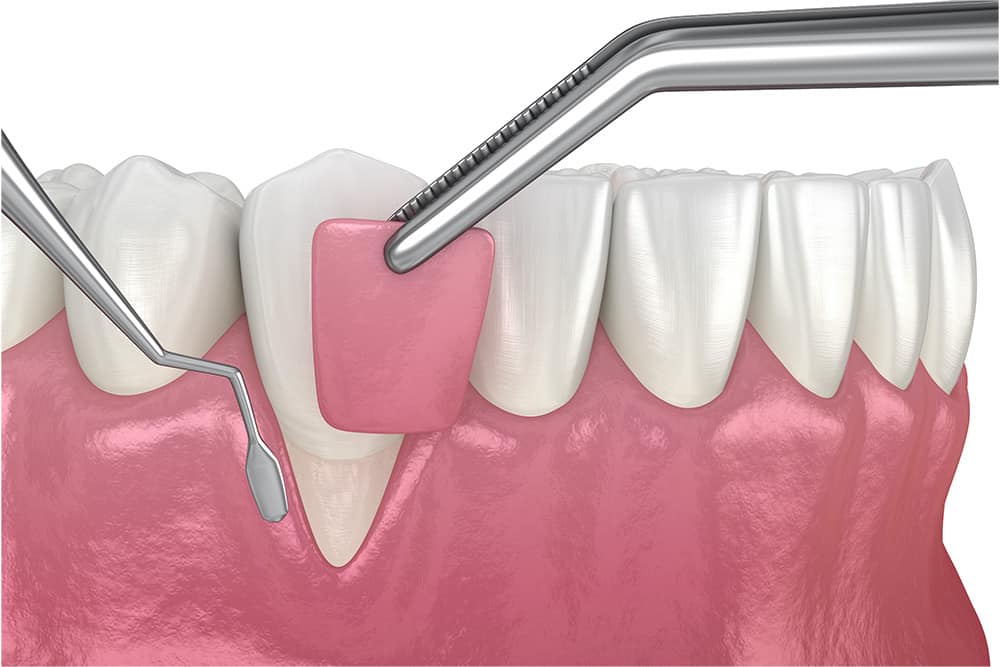Receding Gums? Try Laser Therapy!
Enhance Your Smile with Soft Tissue Grafts!
We can enhance your smile by providing permanent tooth roots coverage through a procedure called Soft Tissue Grafts. This standard method treats receding gums by re-establishing your gum line, preventing further degradation, and enhancing your smile. Soft-Tissue Grafting is a minor dental surgical procedure that uses your soft tissue or a commercially available option. Success rates are higher when performed by an experienced periodontist. Dr. Pradeep Adatrow, with over 17 years of expertise in gum treatments, is the best expert for handling Soft Tissue Grafts.
4E’s : Benefits of soft tissue grafting
for receding gums

- Enhanced Comfort: Covers exposed root conditions and receding gums, reducing pain and discomfort, while improving gum health.
- Enhanced Beauty: Addresses periodontal disease gum recession, making the smile more symmetrical and aesthetically pleasing.
- Enhanced Confidence: A better smile and improved gum health significantly boost confidence.
- Enhanced Gum Protection: Combats periodontal damage, prevents tissue and bone deterioration, and reduces further exposed roots when used with deep cleaning.
Frequently Asked Questions on Soft Tissue Grafts
What Are Soft Tissue Grafts?
Soft-tissue grafting is a common method to re-establish your gum line, prevent further degradation of gums, and enhance your smile. This minor surgical procedure utilizes either your own soft tissue or a commercially available option.
Healing Time
Soft tissue grafting generally takes about four to six weeks to heal.
What Is Gum Recession?
Gum recession refers to the condition where the gum tissue deteriorates, exposing the tooth’s root. This condition increases the risk of discomfort, sensitivity, and potential tooth loss.
Types of Gum Grafting (Soft Tissue Grafting)
- Connective Tissue Grafts
- Free Gingival Grafts
- Pedicle Grafts
- Hole Technique Grafts
- Allografts
Causes of Gum Recession
- Genetics
- Poor Oral Hygiene
- Improper or Aggressive Brushing
- Lack of Dental Treatment
- Advanced Gingivitis (Gum Disease)
What Is Connective Tissue Gingival Grafting?
In connective tissue gingival grafting, a flap of skin is lifted from the palate of the mouth, and subepithelial connective tissue is extracted to cover exposed root surfaces. After the tissue removal, the flap is stitched back into place.
What is the Hole Technique of Gingival Grafting?
The hole technique is a less invasive method for treating gingival recession. This procedure involves making a small hole in the receding gum tissue. A tool is inserted to extend the gum to a stable position. After repositioning, collagen strips are placed in the hole to secure the gums and promote new tissue growth. This method is minimally invasive compared to traditional soft tissue grafting, which uses sutures to hold the gums in place.
How is Soft Tissue Grafting Performed?
- Deep Cleaning: Deep cleaning of the teeth and roots is essential to remove calculus (tartar) above and below the gum line.
- Anesthesia: The grafting procedure is usually done under local anesthesia, depending on the area being treated.
- Incision: A small incision is made at the recipient site to create a pocket.
- Placement: Donor tissue is placed between the two parts of the incision. The donor tissue strip is generally larger than the incision.
- Growth Factors: The site might be treated with platelet-rich growth factors and proteins to stimulate tissue growth and promote healing.
- Suturing: The wound site is sutured to prevent movement, and surgical material is applied to protect the area.
Book An Appoinment
Ready for a New Smile?
“Ready for expert dental care? Book your appointment today at Advanced Dental Implant and TMJ treatment Southaven, MS. Our specialists provide top-tier treatments, from dental implants to TMJ solutions. Convenient online or phone booking available!”
